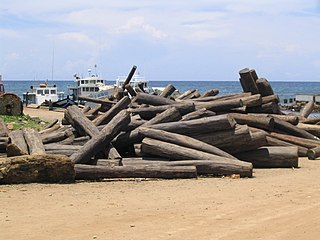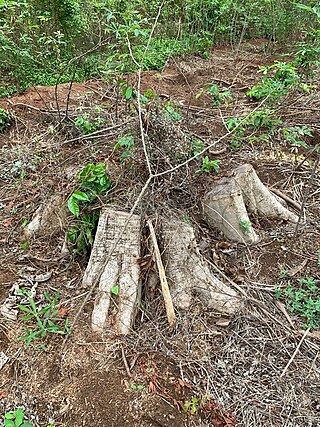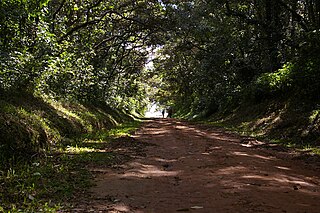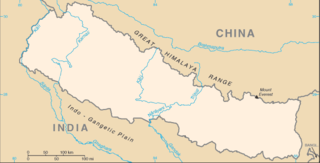
Deforestation or forest clearance is the removal and destruction of a forest or stand of trees from land that is then converted to non-forest use. Deforestation can involve conversion of forest land to farms, ranches, or urban use. About 31% of Earth's land surface is covered by forests at present. This is one-third less than the forest cover before the expansion of agriculture, with half of that loss occurring in the last century. Between 15 million to 18 million hectares of forest, an area the size of Bangladesh, are destroyed every year. On average 2,400 trees are cut down each minute. Estimates vary widely as to the extent of deforestation in the tropics. In 2019, nearly a third of the overall tree cover loss, or 3.8 million hectares, occurred within humid tropical primary forests. These are areas of mature rainforest that are especially important for biodiversity and carbon storage.

Reforestation is the practice of restoring previously existing forests and woodlands that have been destroyed or damaged. The prior forest destruction might have happened through deforestation, clearcutting or wildfires. Three important purposes of reforestation programs are for harvesting of wood, for climate change mitigation, and for ecosystem and habitat restoration purposes. One method of reforestation is to establish tree plantations, also called plantation forests. They cover about 131 million ha worldwide, which is 3% of the global forest area and 45% of the total area of planted forests.

Illegal logging is the harvest, transportation, purchase, or sale of timber in violation of laws. The harvesting procedure itself may be illegal, including using corrupt means to gain access to forests; extraction without permission, or from a protected area; the cutting down of protected species; or the extraction of timber in excess of agreed limits. Illegal logging is a driving force for a number of environmental issues such as deforestation, soil erosion and biodiversity loss which can drive larger-scale environmental crises such as climate change and other forms of environmental degradation.

Environmentally, Colombia is a mega-diverse country from its natural land terrain to its biological wildlife. Its biodiversity is a result of its geographical location and elevation. It is the fourth largest South American country and only country in South America to have coasts on the Pacific and Caribbean Sea. Colombia's terrain can be divided into six main natural zones: The Caribbean, the Pacific, The Orinoco region, The Amazonia region, the Andean region, and the Insular region. 52.2% of the environment is predominately the Andes, Amazon, and Pacific Basins, followed by the Orinoco basin 13.9%, the Andes and the Caribbean. The Tropical Andes, Choco, and the Caribbean are considered biodiversity hotspots which puts these areas at high risk of concentration of colonizing activities. Colombia host over 1800 bird species and at least one new species are detected every year. Decades of civil war and political unrest have impeded biological and environmental research in Colombia. The political unrest in Colombia catalyzes the alteration of land patterns through the cultivation of coca and opium crops, the redirection of extractive activities, and land abandonment in some areas.
Deforestation during the Roman period was a result of the geographical expansion of the Roman Empire, with its increased population, large-scale agriculture, and unprecedented economic development. Roman expansion marks the transition in the Mediterranean from prehistory to the historical period beginning around 500 BC. Earth sustained a few million people 8,000 years ago and was still fundamentally pristine, but Rome drove human development in Western Europe and was a leading contributor of the deforestation around the Mediterranean.

Forestry in India is a significant rural industry and a major environmental resource. India is one of the ten most forest-rich countries of the world. Together, India and 9 other countries account for 67 percent of the total forest area of the world. India's forest cover grew at 0.20% annually over 1990–2000, and has grown at the rate of 0.7% per year over 2000–2010, after decades where forest degradation was a matter of serious concern.

Brazil once had the highest deforestation rate in the world and in 2005 still had the largest area of forest removed annually. Since 1970, over 700,000 square kilometres (270,000 sq mi) of the Amazon rainforest have been destroyed. In 2001, the Amazon was approximately 5,400,000 square kilometres (2,100,000 sq mi), which is only 87% of the Amazon's original size. According to official data, about 729,000 km² have already been deforested in the Amazon biome, which corresponds to 17% of the total. 300,000 km² have been deforested in the last 20 years.

Deforestation is a complex and intertwined environmental and social problem in Haiti. The most-recent national research on charcoal estimates that approximately 946,500 metric tons of charcoal are produced and consumed annually in Haiti, making it the second-largest agricultural value chain in the country and representing approximately 5% of GDP.

The extensive and rapid clearing of forests (deforestation) within the borders of Nigeria has significant impacts on both local and global scales.

The Amazon rainforest, spanning an area of 3,000,000 km2, is the world's largest rainforest. It encompasses the largest and most biodiverse tropical rainforest on the planet, representing over half of all rainforests. The Amazon region includes the territories of nine nations, with Brazil containing the majority (60%), followed by Peru (13%), Colombia (10%), and smaller portions in Venezuela, Ecuador, Bolivia, Guyana, Suriname, and French Guiana.

Deforestation is one of the most serious environmental issues in Sri Lanka. Sri Lanka's current forest cover as of 2017 was 29.7%. In the 1920s, the island had a 49 percent forest cover but by 2005 this had fallen by approximately 26 percent. or 24-35%. Between 1990 and 2000, Sri Lanka lost an average of 26,800 ha of forests per year. This amounts to an average annual deforestation rate of 1.14%. Between 2000 and 2005 the rate accelerated to 1.43% per annum. However, with a long history of policy and laws towards environmental protection, deforestation rates of primary cover have decreased 35% since the end of the 1990s thanks to a strong history of conservation measures. The problem of deforestation in Sri Lanka is not as significant in the southern mountainous regions as it is in northern and lowland southern Sri Lanka, largely due to the nature of environmental protection.

Rates and causes of deforestation vary from region to region around the world. In 2009, two-thirds of the world's forests were located in just 10 countries: Russia, Brazil, Canada, the United States, China, Australia, the Democratic Republic of the Congo, Indonesia, India, and Peru.

Central American countries have experienced cycles of deforestation and reforestation since the decline of Maya civilization, influenced by many factors such as population growth, agriculture, narcotic distribution and illegal practices. From 2001 to 2010, 5,376 square kilometres (2,076 sq mi) of forest were lost in the region. In 2010 Belize had 63% of remaining forest cover, Costa Rica 46%, Panama 45%, Honduras 41%, Guatemala 37%, Nicaragua 29%, and El Salvador 21%. Most of the loss occurred in the moist forest biome, with 12,201 square kilometers. Woody vegetation loss was partially set off by a plus in the coniferous forest biome with 4,730 km2, and at 2,054 km2. Mangroves and deserts contributed only 1% to the loss in forest vegetation. The bulk of the deforestation was located at the Caribbean slopes of Nicaragua with a minus of 8,574 square kilometers of forest lost in the period from 2001 to 2010. The most significant regrowth of 3,050 km2 of forest was seen in the coniferous woody vegetation of Honduras.
The principal environmental issues in Peru are water pollution, soil erosion, pollution and deforestation. Although these issues are problematic and equally destructive, the Peruvian Environmental ministry has been developing regulation and laws to decrease the amount of pollution created in major cities and have been making policies in order to decrease the present deforestation rate in Peru.

An immense number of bird species live in the Amazon rainforest and river basin. Over 1,300 of these species are types of birds, which accounts for one-third of all bird species in the world. The diets of rainforest birds greatly differ between species, although, nuts, fruits and leaves are a common food for many birds in the Amazon. Birds migrate to the Amazon rainforest from the North or South. Amazon birds are threatened by deforestation since they primarily reside in the treetops. At its current rate of destruction, the rainforest will be gone in forty years. Human encroachment also negatively affects the habitat of many Amazonian birds. Agriculture and road clearings limits the habitable areas. Birds in the Amazon are distinguished by which layer of the rainforest they reside in. Each layer or community has unique plants, animals and ecosystems. Birds interact with other animals in their community through the food chain, competition, mating, altruism and symbiosis.

Kenya's forests are fragmented across the country. Combined, forests cover over 37 million hectares. Out of those 37 million hectares, 2.1 million are woodlands, 24.8 million are bush lands and 10.7 are wooded grasslands. Kenya's forests are important at a global level as they host 1847 species of amphibians, birds, mammals, and reptiles of which 4% are only found in Kenya. Beyond its fauna, Kenya's forest also hosts 6505 types of vascular plants, with 4.1% only being found in Kenya. Today Kenya faces high rates of deforestation which endanger both its fauna and flora. It has been estimated that since Kenya's independence in 1963, the forest cover has dropped from 10% of the nation to 6%, losing approximately 12,000 hectares annually. These levels of deforestation have impacted Kenya as they rely on the forest for the storage of rainwater, the prevention of flooding, the fertility of the soil, and the regulation of climate conditions. The World War II period and its aftermath made it clear to British colonial administration that reform was needed to sustain Kenyan forests. One of the first steps for conservation took place with the 1941 revision of the Forest Ordinance that passed legislation to create forest reserves and create a committee with professionals on matters of conservation. By 1950, the forest department had gained control of 100,000 acres, but it had a difficult time sustaining the conservation of these areas; it required meaningful policy to meet the constant attention these areas needed.

Deforestation in the Democratic Republic of the Congo (DRC) is an environmental conflict of international importance. Most of the deforestation takes place in the Congo Basin, which has the second largest rainforest in the world after the Amazon. Roughly half the remaining rainforest in the Congo Basin is in the DRC.

Deforestation in Nepal has always been a serious issue, which has a severe effect on the lives of poor people. In the past, Nepal was a widely forested nation. However now with the requirement for the extension of rural areas, migration of hills people to the plains, the developing regional interest for timber, and the local residents dependence on firewood as the essential source of energy, less than 30% of the nation's forest cover remains. Due to the continuous deforestation in Nepal, many people and creatures are dying. Around 70 percent of the people in Nepal work in agriculture, even if it is difficult to farm in the prevailing unfavourable weather conditions.

Illegal mining is mining activity that is undertaken without state permission. Illegal mining is the extraction of precious metals without following the proper procedures to participate in legal mining activity. These procedures include permits and licenses for exploration of the land, mining and transportation.

Deforestation is the purposeful clearing of forested land. Zimbabwe hosts some of the most important biodiversity hotspots in the world and is home to species of plants and animals. Forests currently cover around 45% of the country’s total land area, but deforestation is an increasingly pressing issue, resulting in forests disappearing quickly. The rate of deforestation in the country accelerated to 327,000 ha per year (1.9%) during the years 2000 and 2010 and is also currently the highest in Southern Africa. In fact, the rate of deforestation in Zimbabwe is one of the highest globally – directly affecting ecosystems, biodiversity, and livelihoods. In 2010, Zimbabwe had 1.06Mha of tree cover, extending over 2.7% of its land area. In 2021, it lost 9.05kha of tree cover, equivalent to 3.82Mt of CO₂ emissions.




















